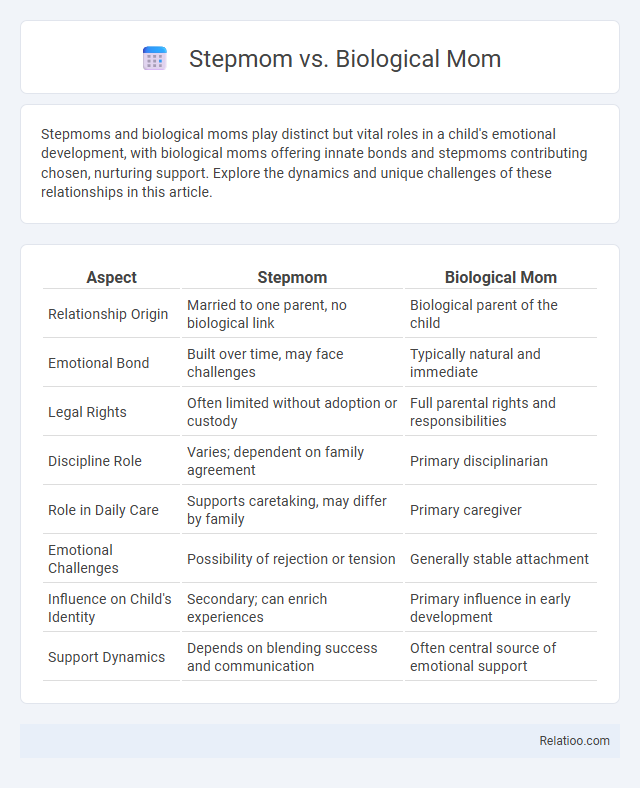Stepmoms and biological moms play distinct but vital roles in a child's emotional development, with biological moms offering innate bonds and stepmoms contributing chosen, nurturing support. Explore the dynamics and unique challenges of these relationships in this article.
Table of Comparison
| Aspect | Stepmom | Biological Mom |
|---|---|---|
| Relationship Origin | Married to one parent, no biological link | Biological parent of the child |
| Emotional Bond | Built over time, may face challenges | Typically natural and immediate |
| Legal Rights | Often limited without adoption or custody | Full parental rights and responsibilities |
| Discipline Role | Varies; dependent on family agreement | Primary disciplinarian |
| Role in Daily Care | Supports caretaking, may differ by family | Primary caregiver |
| Emotional Challenges | Possibility of rejection or tension | Generally stable attachment |
| Influence on Child's Identity | Secondary; can enrich experiences | Primary influence in early development |
| Support Dynamics | Depends on blending success and communication | Often central source of emotional support |
Introduction: Understanding Stepmom vs Biological Mom
Stepmoms often face unique challenges compared to biological moms due to societal expectations and social stigma surrounding blended families. Biological moms are typically seen as the primary caregivers, which can lead to misconceptions about the role and legitimacy of stepmothers. Understanding the nuanced dynamics between stepmoms and biological moms is essential to addressing stereotypes and promoting positive family relationships.
Defining the Roles: Stepmom and Biological Mom
The roles of stepmom and biological mom differ in emotional bonds and societal expectations, with biological moms often seen as primary caregivers due to genetic ties, while stepmoms navigate complex family dynamics to build trust and support. Social stigma may challenge stepmoms by questioning their legitimacy or influence within the family, whereas biological moms typically receive unchallenged recognition. Understanding these distinctions helps you appreciate the unique contributions and challenges each role entails in blended families.
Emotional Bonds: Similarities and Differences
Stepmoms and biological moms both form deep emotional bonds with children, but these connections often develop differently due to varying degrees of time, trust, and social acceptance. Your relationship with a stepmom may face social stigma that questions her role and emotional legitimacy compared to a biological mom, impacting the attachment process. Despite these challenges, love and consistent support can bridge gaps, creating meaningful and lasting bonds for the child's well-being.
Parenting Styles: Contrasts and Influences
Stepmoms and biological moms often adopt different parenting styles influenced by family dynamics and social stigma, with biological moms typically exhibiting more authoritative approaches rooted in lifelong bonding, while stepmoms may lean towards permissive or supportive roles to build trust. These contrasting styles impact children's emotional development and behavioral outcomes, with research showing that your ability to navigate social perceptions significantly shapes family cohesion. Understanding these influences helps stepmoms and biological moms optimize their parenting techniques for healthier relationships despite societal judgments.
Navigating Loyalty and Conflict
Navigating loyalty conflicts between a stepmom and a biological mom requires understanding social stigma often attached to blended families, where stepmoms may face unwarranted distrust or exclusion. Establishing clear communication and setting boundaries can help balance relationships, reducing feelings of competition or guilt among all parties. Prioritizing the children's emotional well-being and fostering cooperative co-parenting practices ultimately mitigates social stigma and promotes family harmony.
Impact on Child’s Well-being
The presence of a stepmom versus a biological mom can significantly affect a child's well-being, as children often experience internal conflicts shaped by family dynamics and social expectations. Social stigma surrounding stepmothers may lead to feelings of exclusion or divided loyalties, impacting the child's emotional development and self-esteem. Supportive family environments that foster positive relationships among all parental figures promote better psychological adjustment and resilience in children.
Communication Strategies for Co-Parenting
Effective communication strategies in co-parenting between stepmoms and biological moms prioritize transparency, respect, and consistency to reduce social stigma and foster a supportive environment for children. Utilizing active listening, setting clear boundaries, and maintaining regular, child-focused dialogue helps bridge relational gaps and diminish societal judgments about non-traditional family structures. Emphasizing shared goals and collaborative problem-solving enhances trust and models positive co-parenting dynamics despite inherent role complexities.
Overcoming Stereotypes and Myths
Stepmoms often face social stigma rooted in stereotypes that portray them as antagonistic or less caring than biological moms, challenges that can impact family dynamics and personal well-being. Overcoming these myths requires acknowledging the unique love and commitment stepmoms bring, supported by open communication and empathy within blended families. Your role transcends outdated labels, proving that nurturing bonds develop through trust and shared experiences rather than genetics alone.
Building Healthy Relationships in Blended Families
Building healthy relationships in blended families requires understanding and addressing the unique challenges faced by stepmoms and biological moms amid social stigma. Effective communication and empathy help dismantle misconceptions, fostering trust and respect between all family members. Your commitment to inclusive family dynamics promotes emotional well-being and strengthens bonds despite societal pressures.
Conclusion: Finding Balance and Cooperation
Balancing the roles of stepmom and biological mom requires open communication and mutual respect to mitigate social stigma and foster a positive family dynamic. Cooperation between both maternal figures enhances the child's emotional well-being and creates a supportive environment. Emphasizing shared goals over rivalry promotes harmony and challenges societal biases around blended families.

Infographic: Stepmom vs Biological Mom
 relatioo.com
relatioo.com